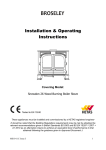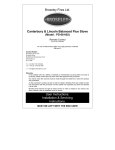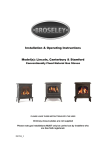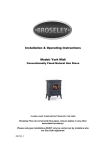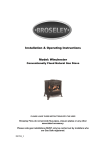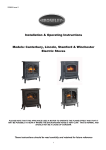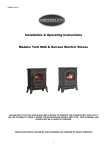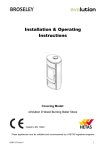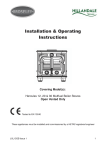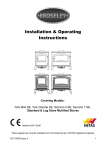Download Broseley eVolution 26 Specifications
Transcript
,QVWDOODWLRQ2SHUDWLQJ
,QVWUXFWLRQV
Covering Models:
H9ROXWLRQ%RLOHU
:RRG%XUQLQJ6WRYH
Tested to EN 13240
These appliances must be installed and commissioned by a HETAS registered engineer
MS10-11C Issue 2
1
Contents
Introduction
Packing List
Health & Safety
3
3
4
Specifications
Dimensions
Hearth Requirements & Clearances
Chimney Requirements
Combustion Air Requirements
Assembly
5
6
7
8
9
10
Plumbing Advice
Plumbing Maintainance
Plumbing Diagrams
Commissioning & Handover
13
20
21
30
Stove Operation
Controls Layout
Controls Explained
31
32
Recommended Fuels
33
Lighting the Stove
Kindling Stage
Burning Wood
Smoke Exempt Requirements
Warning Notes
34
35
36
37
Maintenance
Ash Removal
Chimney Fires
General Stove Cleaning
Glass Cleaning
Annual Stove Service
Chimney Sweeping
Flue Ways & Boiler Cleaning
38
38
38
38
38
39
39
Trouble-shooting
Commissioning Form
Spare Parts
EC Declaration
Annual Service Record
Warranty
40
41
43
44
45
46
MS10-11C Issue 2
2
Introduction
May we take this opportunity to thank you for choosing one of our stoves.
These appliances are designed to burn hardwood logs. It is essential that your wood has
been seasoned to ensure that it is sufficiently dry for burning. You can determine the
moisture content of your logs by using a digital moisture meter, your logs need to be below
20% moisture content (Preferably in the centre of the log) before they are considered dry
enough for burning. Never burn wood that contains paint, glue or any other chemicals
See the section “Recommended Fuels” & “Lighting the Stove” for further details. After
reading this document, if there is anything you are unsure about, please contact your
dealer or our Technical Support Department.
These instructions cover the basic principles to ensure the satisfactory installation of the
stove, although detail may need slight modification to suit particular local site conditions. In
all cases the installation must comply with current Building Regulations, Local Authority
By-laws and other specifications or regulations as they affect the installation of the stove.
It should be noted that the Building Regulations requirements may be met by adopting the
relevant recommendations given in British Standards BS 8303, BS 6461 and BS 7566 as
an alternative means to achieve an equivalent level of performance to that obtained
following the guidance given in Approved Document J.
Please note that it is a requirement under the Broseley Fires warranty system that
the installation of the stove is carried out by a Competent Person registered with a
Government approved Competent Persons Scheme. HETAS Ltd operate such a
Scheme and a listing of their Registered Competent Persons can be found on their
website at www.hetas.co.uk. Your installer is responsible for designing and
implementing any aspect of the installation, he/she may sub-contract certain areas
but all work must be done to your installers design and specification.
3DFNLQJ/LVW
1x Cast Iron/Steel Stove
2x Rear Firebricks
4x Bottom Firebricks
1x Front Baffle
1x Grate Support Set
2x Side Firebricks
4x Grates
2x Ashpans
1x Log retainer set
1x Spigot & Fixings
1x Spigot Ring
1x Ash Tool & Glove Set
1x Smoke Exempt Washer
1x Instruction Booklet
All seperate parts will be inside the main stove body.
MS10-11C Issue 2
3
+HDOWK6DIHW\
Special care must be taken when installing the stove such that the requirements of the
Health and Safety at Work Act are met.
Installation
This appliance MUST be installed and commisioned by a HETAS registered installer in
England and Wales and a fully qualified Heating Engineer in Scotland and Ireland.
Handling
Adequate facilities must be available for loading, unloading and site handling.
Fire Cement
Some types of fire cement are caustic and should not be allowed to come into contact with
the skin. In case of contact wash immediately with plenty of water.
Asbestos
This stove contains no asbestos. If there is a possibility of disturbing any asbestos in the
course of installation then please seek specialist guidance and use appropriate protective
equipment.
Metal Parts
When installing or servicing this stove care should be taken to avoid the possibility of
personal injury.
CO Alarms
Building regulations require that whenever a new or replacement fixed solid fuel or
wood/biomass appliance is installed in a dwelling an audible carbon monoxide alarm must
be fitted in the same room as the appliance. Further guidance on the installation of the
carbon monoxide alarm is available in BS EN 50292:2002 and from the alarm
manufacturer’s instructions. Provision of an alarm must not be considered a substitute for
either installing the appliance correctly or ensuring regular servicing and maintenance of
the appliance and chimney system.
Fire Guards
When using the stove in situations where children, aged and/or infirm persons are present
a fireguard must be used to prevent accidental contact with the stove. The fireguard
should be manufactured in accordance with BS 6539.
Aerosol Sprays
Do not use an aerosol spray on or near the stove when it is alight.
Operating Tool & Gloves
Always use the operating tool and glove provided when handling parts likely to be hot
when the stove is in use.
MS10-11C Issue 2
4
6SHFLILFDWLRQV
In the UK these stoves have been approved by HETAS Ltd as intermittent heating
appliances for burning Hardwood logs only.
Appliance Weight (Kg)
Nominal total heat output
Nominal heat output to room (kW)
Nominal heat output to water (kW)
Flue diameter MINIMUM
Efficiency %
Maximum fuel load of wood to maintain nominal output (Kg / hr)
Maximum wood length – Must be Split Logs
Wood Moisture Content /HVVWKDQ
Temperature exhaust gas – wood (ºC)
Optimal working temperature
Boiler capacity (Litres)
Flow & return pipe fitting (Female)
SCWS flow & outlet pipe fittings (Male)
Flue draft Pressure (Pascals)
Minimum flue height in meters (straight)
Maximum working temperature
Maximum allowable water pressure (bar)
320
25.9
10.1
15.8
150mm/6”
77.9
5.69
35cm
20.00%
241
zz
30
1” BSP
ߢ%63
14 – 20
5
zz
3
European standards need to be complied to when installing this appliance.
MS10-11C Issue 2
5
'LPHQVLRQV
All dimensions are in millimetres
MS10-11C Issue 2
6
+HDUWK5HTXLUHPHQWV&OHDUDQFHV
This appliance is suitable for non-combustible hearths with a minimum thickness of
12mm, they do not require a full constructional hearth.
Your stove must be installed on a solid, level non-combustible hearth. The hearth
protrusion in front of the stove to carpets or wooden floors must be at least 300mm. As it is
possible, that on opening the door of the stove for fuel to fall out, a fender must be fitted if
the hearth is flush with the carpet. These are just a few hearth specifications. Please refer
to Building Regulations Approved Document J (Hearths) for more specific details.
Clearances
The stove requires the following clearances around it to ensure the heat is released into
the room and to allow sufficient combustion air flow. A combustible material clearance is
given to prevent damage to any items that may be affected by heat.
Stove Clearances
Non-Combustible
Combustible
MS10-11C Issue 2
Rear
150mm
150mm
Side
100mm
150mm
Hearth
300mm
300mm
Above
200mm
600mm
7
&KLPQH\5HTXLUHPHQWV
This appliance must not be fitted into a chimney serving another heating appliance. It is
most important that there is no obstruction in the flue or chimney. Please ensure that any
existing chimney is clear of obstruction and swept clean immediately before installation of
the new stove. If the chimney has been used for an open fire it is recommended that it be
swept for a second time having been used for a month following installation.
A flue draught minimum of 14 Pascals to a maximum 20 Pascals is required for
satisfactory appliance performance. A properly built masonry or factory constructed
chimney (with a minimum vertical height of 5 metres) should ensure a consistent draught
(draw). 45° bends can be used in the flue run (maximum of four bends) you will need to
add an extra 1 metre of vertical flue height for each bend.
The flue draught should be checked under fire at high output and if it exceeds the
recommended maximum, a draught stabiliser must be fitted so that the rate of burning can
be controlled, and to prevent over firing (See section “Warning Notes”). If you have any
doubts about the suitability of your chimney, consult your local dealer/stockist or engineer.
If your flue draft is below the minimum recommendation then it may be neccesary to
increase the vertical chimney height, add additional flue insulation or possibly add a
special cowl to the top of the chimney (e.g. anti down draft cowl to eliminate wind induced
down draft).
The outlet from the chimney should be above the roof of the building in accordance with
the provisions of Building Regulations Approved Document J.
If installation is into an existing chimney then it must be sound and have no cracks or other
faults which might allow fumes into the house. Older properties, especially, may have
chimney faults or the cross section may be too large i.e. more than 230 mm x 230 mm.
Remedial action should be taken, if required, seeking expert advice, if necessary. If it is
found necessary to line the chimney then a flue liner suitable for solid fuel must be used in
accordance with Building Regulations Approved Document J.
If there is no existing chimney then either a prefabricated block chimney in accordance
with Building Regulations Approved Document J or a twin walled insulated stainless steel
flue to BS 4543 can be used. These chimneys must be fitted in accordance with the
manufacturer’s instructions and Building Regulations.
If a flexible liner is required the liner diameter must not be less than 6”.
Any bend in the chimney or connecting fluepipe should not exceed 45°. 90° bends are not
permitted. . For top flue installations it is possible to sweep through the appliance by
removing the internal baffle however it is recommended that you provide adequate access
(e.g. easily accessible soot door).
MS10-11C Issue 2
8
&RPEXVWLRQ$LU5HTXLUHPHQWV
In order for the stove to perform efficiently and safely there should be an adequate air
supply into the room in which the stove is installed to provide combustion air. This is
particularly necessary in modern houses where drafts have been almost eliminated by
double glazing etc.
Under UK building regulations any appliance over 5kW MUST have a fixed
permanent air vent (see building regulations approved document J for further
information).
There must not be an extractor fan fitted in the same room as the stove as this can cause
the stove to emit fumes into the room. It is necessary to install a wall vent to provide the
necessary combustion air and to prevent the depletion of oxygen in the room.
It is possible to direct vent this appliance by connecting a 150mm/6” diameter pipe to the
spiggot on the back of the appliance using a suitable pipe and clip (not supplied).
MS10-11C Issue 2
9
$VVHPEO\
The diagrams below shows the main removable components of the stove
It is possible to remove these components for transportation.
Front Casting Assembly:
MS10-11C Issue 2
10
$VVHPEO\
Installing/removing the internal firebricks
.
To install these components simply follow the numbered sequence 1-14, to remove simply
reverse the sequence.
Please note that Item 2 is an additional baffle that is NOT required for installations in the
UK and the Republic of Ireland and should be removed entirely (If not already removed).
Item 5 is rope which sits underneath the rear firebricks (item 6).
MS10-11C Issue 2
11
$VVHPEO\
When installing this appliance into a smoke control area you will need to change the clip
that is attached to the rear of the air slider for the smoke exempt clip (supplied). The
smoke exempt clip ensures a constant supply of combustion air to meet smoke exempt
requirements.
FOR MODELS MANUFACTURED PRE 2013 THE AIR SLIDER WILL COME PRESET
FOR SMOKE EXEMPT AREAS. FOR INSTALLATIONS NOT IN SMOKE CONTROL
AREAS YOU WILL SIMPLY NEED TO REMOVE THE RETAINING SCREW WHICH
OTHERWISE PREVENTS THE SLIDER FROM FULLY CLOSING.
MS10-11C Issue 2
12
3OXPELQJ$GYLFH
Boiler installations should only be carried out by qualified heating engineers who
hold a HETAS wet systems certificate or equivalent. Installations incorporating the
SCWS (Safety Cold Water System) should ONLY be carried out by those engineers
who have completed the SCWS training course or an equivelent Biomass training
course.
If connected to an unvented heating system, this appliance must (as a minimum) have the
following components installed on the system to ensure the safe operation of the
appliance:
1) WATTS STS220 – Thermal discharge Valve (supplied)
2) WATTS KSG 30 – Safety Pressure Relief Valve (supplied)
3) Expansion Vessel comprising 7% of the total system volume (not supplied)
4) If connected in conjunction with a Gas Combination Boiler you will need a “Low Loss
Header” to link the boilers together; this will ensure that there is no conflict between the
two boilers. The low loss header should be sized and provided by the heating engineer.
MS10-11C Issue 2
13
3OXPELQJ$GYLFH
The eVolution 26 Stove differs from normal boiler stoves in the fact that it can be installed
on an open vented or sealed/pressurised heating system. When installing the appliance on
a sealed system, it is necessary to install added safety features which allow the stove to
be installed safely.
The eVolution has several options regarding water circuit safety. The components used,
and why each is required, are detailed below.
DESCRIPTION OF SAFETY COMPONENTS
SCWS
The SCWS prevents the boiler reaching
100°C. This works by transferring the heat in
the boiler away through a secondary quench
coil situated inside the boiler. The quench coil
is activated by a thermal safety valve (Watts
STS20) which activates at 97°C. The thermal
safety valve needs to be connected to mains
water and drained suitably through an outside
wall, in accordance with G3 regulations.
The Thermal Safety Valve needs to be connected to a mains water supply and then to the
quench coil in the boiler. Both openings are ¾ inch female connections. There should be a
minimum pressure of 1.5 bar mains water supply to the SCWS. The maximum operating
pressure is 8 bar.
IF YOU CANNOT GUARANTEE A SUITABLE WORKING PRESSURE THEN THE
APPLIANCE SHOULD NOT BE INSTALLED
The discharge from the safety coil needs to be
discharged through an outside wall and terminated at
a low level within a 100mm through a metal pipe that
naturally drains. The discharge pipe should be in
accordance with G3 regulations. The thermal safety
valve probe needs to be inserted into the tube and ½
inch tapping in the rear of the boiler.
To ensure correct operation of the thermal safety drain over the
long-term, periodic drainage of the valve is required (at least
once a year); to perform such operation, press the red discharge
button located at the top of the valve head. Such operation allows
cleaning the seal seat where foreign particles build up. After a
certain number of periodic cleaning operations, it is advisable to
replace the valve plug which is supplied as spare part.
MS10-11C Issue 2
14
3OXPELQJ$GYLFH
Safety blow off
The safety blow off valve acts as a final safety option in case of
failure of the SCWS. This is supplied incorporating a 3bar
pressure relief valve, a pressure gauge and an automatic air
vent. This must be placed within 1 meter of the appliance.
The safety blow off discharge pipework should will be 28mm
pipe work
N.B. the use of a quench coil does not affect the primary system volume and therefore
allows the system to recover and resume normal operation when the boiler has cooled
adequately. The use of the pressure blow off however will reduce the primary water
volume and drop the system pressure this will require the system to be refilled and
checked before it can be used again. Running a boiler without water in it can damage the
appliance and pumps allowed to run without water in them will quickly overheat and fail.
Back end protection
The back end protection is a three-way valve (regulated by
temperature) that improves the efficiency of the boiler, reduces
condensation and actively prolongs the longevity of the boiler. It
does this by not allowing cold water from the heating system to be
directly introduced into the boiler until a desired temperature is
reached, in this case 55°C.
The valve used is an ESBE VTC511 or equivalent.
D
Improves efficiency by not robbing heat from the fire.
D
Reduces boiler condensation and prolongs the life of the boiler by not allowing
water from condensation to mix with smoke particles potentially creating harmful
acids and toxins which can have detrimental effects on the boiler.
D
Helps reduce tarring inside the appliance and flue
Tarring may also result from burning wet wood with a moisture content greater than 20%
MS10-11C Issue 2
15
3OXPELQJ$GYLFH
Expansion vessels
The boiler must be directly connected to the expansion vessel in the system using a pipe
with a diameter no smaller than 18mm. The piping must not be obstructed in any way. The
expansion vessel must be at least 7% of volume of the total heating system. The
expansion vessel should be fitted on the suction side of the pump. The point at which it is
fitted is generally accepted as being the neutral point of the system. An expansion vessel
is divided into two compartments and separated by a flexible diaphragm. The sealed side
is charged with nitrogen gas. The open side is connected to the system.
Sizing of an expansion vessel:
Sizing of an expansion vessel is very important as the expansion vessel must be large
enough to accommodate all the expansion of the water.
D
D
D
The volume of water contained within the system. Manufacturers supply data which
includes water capabilities of such things as boilers and heat emitters.
Initial pressure of system, or pre-pressurisation, calculated from the static height
which is the vertical distance from the expansion vessel to the highest point.
The boiler flow temperature. Should the volume fall between two sizes, the larger
size must be used. The volume of the expansion vessel in litres fitted to a sealed
system shall not be less than that given by the table below.
^ĂĨĞƚLJǀĂůǀĞƐĞƚƚŝŶŐ;ďĂƌͿ
sĞƐƐĞůĐŚĂƌŐĞƉƌĞƐƐƵƌĞ;ďĂƌͿ
/ŶŝƚŝĂůƐLJƐƚĞŵƉƌĞƐƐƵƌĞ;ďĂƌͿ
dŽƚĂůǁĂƚĞƌĐŽŶƚĞŶƚŽĨƐLJƐƚĞŵ
Ϯϱ
ϱϬ
ϳϱ
ϭϬϬ
ϭϮϱ
ϭϱϬ
ϭϳϱ
ϮϬϬ
ϮϱϬ
ϯϬϬ
ϯϱϬ
ϰϬϬ
ϰϱϬ
ϱϬϬ
MS10-11C Issue 2
3
Ϭ͘ϱ
Ϯ͘ϭ
ϰ͘Ϯ
ϲ͘ϯ
ϴ͘ϯ
ϭϬ͘ϰ
ϭϮ͘ϱ
ϭϰ͘ϲ
ϭϲ͘ϳ
ϮϬ͘ϴ
Ϯϱ
Ϯϵ͘ϭ
ϯϯ͘ϯ
ϯϳ͘ϱ
ϰϭ͘ϲ
Ϭ͘ϱ
ϭ
ϯ͘ϱ
ϳ
ϭϬ͘ϱ
ϭϰ
ϭϳ͘ϱ
Ϯϭ
Ϯϰ͘ϱ
Ϯϴ
ϯϱ
ϰϮ
ϰϵ
ϱϲ
ϲϯ
ϳϬ
ϭ
Ϯ
ϭ
ϭ͘ϱ
1.5
Expansion Vessel Volume (litres)
ϲ͘ϱ
ϭϮ͘ϵ
ϭϵ͘ϰ
Ϯϱ͘ϵ
ϯϮ͘ϰ
ϯϴ͘ϴ
ϰϱ͘ϯ
ϱϭ͘ϴ
ϲϰ͘ϳ
ϳϳ͘ϳ
ϵϬ͘ϲ
ϭϬϯ͘ϲ
ϭϭϲ͘ϱ
ϭϮϱ͘ϵ
ϭϯ͘ϳ
Ϯϳ͘ϱ
ϰϭ͘ϯ
ϱϱ͘ϭ
ϲϴ͘ϵ
ϴϮ͘ϲ
ϵϲ͘ϰ
ϭϭϬ͘Ϯ
ϭϯϳ͘ϳ
ϭϲϱ͘ϯ
ϭϵϮ͘ϴ
ϮϮϬ͘ϰ
Ϯϰϳ͘ϵ
Ϯϳϱ͘ϱ
Ϯ͘ϳ
ϱ͘ϰ
ϴ͘Ϯ
ϭϬ͘ϵ
ϭϯ͘ϲ
ϭϲ͘ϯ
ϭϵ͘ϭ
Ϯϭ͘ϴ
Ϯϳ͘Ϯ
ϯϮ͘ϳ
ϯϴ͘ϭ
ϰϯ͘ϲ
ϰϵ
ϱϰ͘ϱ
ϰ͘ϳ
ϵ͘ϱ
ϭϰ͘Ϯ
ϭϵ
Ϯϯ͘ϳ
Ϯϴ͘ϱ
ϯϯ͘Ϯ
ϯϴ
ϰϳ͘ϱ
ϱϳ
ϲϲ͘ϱ
ϳϲ
ϴϱ͘ϱ
ϵϱ
1.5
Ϯ
ϭ͘ϱ
2
ϭϬ͘ϯ
ϮϬ͘ϲ
ϯϬ͘ϵ
ϰϭ͘Ϯ
ϱϭ͘ϱ
ϲϭ͘ϴ
ϳϮ͘ϭ
ϴϮ͘ϭ
ϭϬϯ
ϭϮϯ͘ϲ
ϭϰϰ͘Ϯ
ϭϲϰ͘ϴ
ϭϴϱ͘ϰ
ϮϬϲ
ϯ͘ϵ
ϳ͘ϴ
ϭϭ͘ϳ
ϭϱ͘ϲ
ϭϵ͘ϱ
Ϯϯ͘ϰ
Ϯϳ͘ϯ
ϯϭ͘Ϯ
ϯϵ
ϰϲ͘ϴ
ϱϰ͘ϲ
ϲϮ͘ϰ
ϳϬ͘Ϯ
ϳϴ
ϴ͘ϯ
ϭϲ͘ϱ
Ϯϰ͘ϴ
ϯϯ͘ϭ
ϰϭ͘ϯ
ϰϵ͘ϲ
ϱϳ͘ϵ
ϲϲ͘Ϯ
ϴϮ͘ϳ
ϵϵ͘ϯ
ϭϭϱ͘ϴ
ϭϯϮ͘ϰ
ϭϰϴ͘ϵ
ϭϲϱ͘ϱ
16
3OXPELQJ$GYLFH
Alarms
It is not a requirement to fit an alarm on the system, but it is recommended. The alarm will
act as a warning to the customer if the SCWS should operate. The alarm should be fitted
to the SCWS discharge pipe and should register an increase in temperature when the
SCWS is in operation. The customer should be notified that if this SCWS system/alarm is
continually operating that measures should be taken to stop the overheating of the
appliance. Measures to take are as follows:
1) Close all the air controls, including the tertiary and thermostatic air controls
2) Run hot water tap to remove some of the hot water in the cylinder (if fitted)
The customers should also be made aware that if there is constant operating of the
SCWS, they should contact the installer to diagnose any problems with the system.
N.B. A boiler that is too large for the required heat load will trigger the SCWS too often and
should therefore be replaced by a boiler that is better suited to the heating load.
It is mandatory to fit the safety components below when running a
closed/pressurised system. Failure to install these components will void your
guarantee and warranty, and risk the possibility of damage, to the extent of the
boiler exploding.
Table of required safety components
KƉĞŶsĞŶƚĞĚ
^ĂĨĞƚLJŽŵƉŽŶĞŶƚ ʹ'ƌĂǀŝƚLJ
^t^
ŶͬĂ
^ĂĨĞƚLJůŽǁKĨĨ
ŶͬĂ
ĂĐŬŶĚWƌŽƚĞĐƚŝŽŶ ŶͬĂ
džƉĂŶƐŝŽŶsĞƐƐĞů
ŶͬĂ
ůĂƌŵ
ŶͬĂ
MS10-11C Issue 2
KƉĞŶsĞŶƚĞĚͲ
WƵŵƉĞĚ
DĂŶĚĂƚŽƌLJ
ŶͬĂ
ZĞĐŽŵŵĞŶĚĞĚ
ŶͬĂ
ZĞĐŽŵŵĞŶĚĞĚ
WƌĞƐƐƵƌŝƐĞĚ
DĂŶĚĂƚŽƌLJ
DĂŶĚĂƚŽƌLJ
DĂŶĚĂƚŽƌLJ
DĂŶĚĂƚŽƌLJ
ZĞĐŽŵŵĞŶĚĞĚ
17
3OXPELQJ$GYLFH
Plumbing the Appliance – Open Vented
This installation should be in accordance with BS 5449:1990 - Specification for
forced circulation hot water central heating systems for domestic premises.
It must include a gravity circuit with an expansion tank open to the atmosphere.
When installing this appliance on a gravity circuit, the system should consist of a
tank/indirect cylinder fixed in an upright position and should be connected to the boiler by
28mm pipe (both flow and return). The pipes should not exceed 7.8m in length. The
shorter the run of pipe work the more effective the appliance is going to be at heating the
water. The cylinder and pipe work should be lagged to minimise the heat loss in the
system.
A ‘heat-leak’ radiator must be incorporated into the system to dissipate any excess heat
produced from the boiler when connected demands are low. The heat leak radiator must
be sized at a minimum of 10% the boiler output. Fit the heat leak radiator in the gravity
circuit using 22mm pipe reducing to 15mm for no more than 300mm before the radiator.
When plumbing the appliance open vented you will need to cap the SCWS discharge pipe
(D) but leave the SCWS flow uncapped (C) The SCWS probe hole will also need to be
capped (E) as it is not needed. (Letters refer to diagram on page 13).
Plumbing the appliance sealed/pressurised system
When installing the appliance on a closed/pressurised system the safety components
mentioned previously MUST be installed. Failure to do this could have very serious
consequences and will void your guarantee and warranty. We have given some examples
at the back of this plumbing advice on how the appliance can be installed in typical
situations. These illustrations should be taken as a guide and not a definitive plumbing
diagram. There is no requirement for a heat leak radiator on a closed system; we would
however recommend installing one radiator that has no thermostat.
Link Up Systems
It is possible to link the eVolution stove to other boilers on a pressurised/closed system.
This however can cause problems with ‘conflicts’ between the two boilers. Any solid fuel
appliance with a boiler can be linked to an existing or new central heating system fired by
another fuel or a second solid fuel appliance. This means that the central heating can be
heated by one or both boilers in tandem, depending on the heat demand.
When linking two or more heat sources together on a sealed system there are a number of
ways to do this, the easiest being via a low loss header.
A low loss header works on the same principals as a neutralizer on an open vented
system. It is a simple method to connect two appliances at a neutral point in order that
there is no hydraulic interaction between them. This means that the pumped circuit from a
second appliance will not induce a flow through the solid fuel boiler.
MS10-11C Issue 2
18
3OXPELQJ$GYLFH
Timer control of a system with a woodburning boiler appliance
As wood burning appliances are not automated, and can therefore not be ignited,
controlled and extinguished by electrical control from a heating programmer it needs to be
borne in mind that any heat produced when the heating is not being called for must be
able to be dissipated in order to negate unnecessary triggering of the safety devices.
The use of a thermostat on the low loss header that runs the CH pump (and opens the
appropriate motorised valves) when there is heat to be distributed is therefore necessary.
There should be provision made on the heating system to ensure that enough radiators (or
under floor heating zones) are permanently open and NOT thermostatically controlled to
allow at least 20% of the wood boilers nominal output.
In installations that only use a wood boiler and therefore have no low loss header a high
limit stat should be fitted to the flow from the boiler, set to ensure that the open circuit can
dissipate at least 20% of the nominal boiler output
Thermal Stores
An alternative way to link up different heat sources is through a Thermal Store; this can
link many appliances together and offers the best storage solution for any hot water
produced. Using a thermal store also allows for the option of linking in solar heating with
your system if required. Typical installation guides for link up systems can be found in the
diagrams at the back of this plumbing advvice section.
Checks on Initial Firing
Before connecting up the boiler, the installer must ensure that they thoroughly flush all of
the system’s pipes in order to remove any residue which could compromise the correct
operation of all system components (pumps, valves etc). It is also important to verify that
the chimney has sufficient draught, there are no blockages and that no other appliance
exhausts are inserted into the flue.
Inform the householder of the safety systems fitted to this stove. Explain the necessity to
maintain the water supply to the SCWS (cooling loop).
Filling up the System
Once all connections are complete, the installer can proceed with the boiler connection.
Open all the vent pipes of the radiators, the boiler and the system. Gradually open the load
valve, ensuring that the air vent pipes are working correctly. Use the gauge to confirm the
system is pressurised. With closed tank systems, a pressure of 0.11 – 0.12 MPa (1.1 – 1.2
bar) must be reached.
MS10-11C Issue 2
19
3OXPELQJ0DLQWHQDQFH
It is essential that your stove is well maintained and annually serviced by a qualified
professional to ensure it's continued efficient operation. Failure to maintain and
service your appliance as laid out in these instructions will result in the voiding of
your products warranty. Please see section “Maintenance” for information on
annual servicing of the stove and its internal components.
Plumbing Servicing
It is critical that all aspects of the SCWS (Safety Cold Water System) are annualy checked
to ensure correct operation. The main safety valve in the SCWS is the Watts STS20 valve,
which will open to allow mains cold water to enter the boilers quench coil. It is necessary to
clean the valve to remove impurities and deposits before initial firing and during servicing
of the installation. To activate the manual discharge and therefore the cleaning, press and
hold the red button on the valve, this will allow water to flow through the valve removing
the deposits. The manual test of this valve MUST be performed at the annual service.
Test Button
MS10-11C Issue 2
20
3OXPELQJ'LDJUDPV
We have given some example plumbing layouts of how the appliance can be installed in
typical situations; these diagrams should be taken as a guide only and not as a definitive
instruction. It is the sole responsibility of the plumbing and heating engineer carrying out
the installation to design the system to suit the property and the clients needs.
The following diagrams are offered as a guide to assist in system design:
Diagram A
Pressurised boiler stove linked with combination gas boiler via a low loss header
Diagram B
Pressurised boiler stove linked with a non combi gas or oil boiler via a low loss header and
the addition of an open vented hot water cylinder.
Diagram C
Pressurised boiler stove linked with a non combi gas or oil boiler via a low loss header and
the addition of a pressurised hot water cylinder.
Diagram D
Pressurised stove linked with a non combi gas or oil boiler via a thermal store with solar for
summer time domestic hot water
Diagram E
Pressurised boiler stove linked with a non combi gas or oil boiler via a thermal store with
solar for domestic hot water and solar support for central heating system.
Diagram F
Stand alone pressurised boiler stove with an open vented hot water cylinder
Diagram G
Stand alone pressurised boiler stove with a pressurised hot water cylinder.
Diagram H
2 pipe open vented system
MS10-11C Issue 2
21
3OXPELQJ'LDJUDPV
Diagram A – Pressurised boiler stove linked with combination gas boiler via a low loss header
MS10-11C Issue 2
22
3OXPELQJ'LDJUDPV
Diagram B – Pressurised boiler stove linked with a non combi gas or oil boiler via a low loss
header and the addition of an open vented hot water cylinder.
MS10-11C Issue 2
23
3OXPELQJ'LDJUDPV
Diagram C – Pressurised boiler stove linked with a non combi gas or oil boiler via a low loss
header and the addition of a pressurised hot water cylinder.
MS10-11C Issue 2
24
3OXPELQJ'LDJUDPV
Diagram D – Pressurised stove linked with a non combi gas or oil boiler via a thermal store with
solar for summer time domestic hot water
MS10-11C Issue 2
25
3OXPELQJ'LDJUDPV
Diagram E - Pressurised boiler stove linked with a non combi gas or oil boiler via a thermal store
with solar for domestic hot water and solar support for central heating system.
MS10-11C Issue 2
26
3OXPELQJ'LDJUDPV
Diagram F – Stand alone pressurised boiler stove with an open vented hot water cylinder
MS10-11C Issue 2
27
3OXPELQJ'LDJUDPV
Diagram G – Stand alone pressurised boiler stove with a pressurised hot water cylinder.
MS10-11C Issue 2
28
3OXPELQJ'LDJUDPV
Diagram H – Two pipe open vented circuit.
MS10-11C Issue 2
29
&RPPLVVLRQLQJ+DQGRYHU
Ensure loose parts are fitted in accordance with the instructions for “Assembly” given
previously. On completion of the installation, allow a suitable period of time for any fire
cement and mortar to dry out; a small fire may then be lit and checked to ensure the
smoke and fumes are taken from the stove up the chimney and emitted safely outdoors.
Do not run at full output for at least 24 hours.
On completion of the installation and commissioning, ensure that this installation and
operation manual for the stove is left with the customer. Ensure the customer is advised on
the correct use of the appliance with the fuels likely to be used on the stove and warn them
to use only the recommended fuels for the stove.
Advise the user what they should do if smoke or fumes be emitted from the stove. The
customer should be warned to use a fireguard to BS 6539 in the presence of children,
aged and/or infirm persons. Advise the user not to fit an extractor fan in the same room as
the stove as this can cause the stove to emit fumes into the room.
MS10-11C Issue 2
30
&RQWUROV/D\RXW
The diagram below shows the position of the air control, this control needs to be operated
correctly to control the combustion rate of the stove.
This air control is classed as the “Secondary Air Intake” as it brings air in above the
grate. See the following section for a more detailed description of how this control works.
MS10-11C Issue 2
31
&RQWUROV([SODLQHG
Fire needs air to burn therefore the stove is fitted with an air control that allows you to
regulate the amount of combustion air therefore controlling the burn rate within the
appliance.
Secondary Air Intake
The secondary air intake is located on the front of the stove below the door, it is in the form
of a slider. Having the slider pushed to the right indicates that the air intake is in the
closed/minimum position and to the left indicates it is in the fully open/maximum position.
Air entering through this control is directed through the holes in the rear of the firebox and
also down the inside of the glass creating the AIRWASH system – see below. The air wash
system allows the glass to remain soot and particle free. This control is used at initial
lighting and to control the burn rate of your wood.
The sections LIGHTING THE STOVE & BURNING WOOD give a step by step guide on
how to operate this control.
Thermostat Control
This control is in the form of a dial which makes the end of the secondary air intake slider,
located on the front of the stove. The thermostat provides an automatically regulated
additional air intake. This air intake will close (cutting off the additional air supply) when the
water temperature inside the boiler reaches 80°c. Turning the dial fully clockwise indicates
the control is completely open (maximum additional combustion air) and fully anticlockwise indicates the control is closed (zero additional combustion air). This particular air
intake is adjustable throughout the rotation of the dial. Please note this control will lock
shut once the water has reached 80°c (once the water temperature drops below this point
you will be able to operate the control again).
Air wash System
Air wash is a system where secondary air is drawn into the stove (by combustion) through
the secondary air control and is deflected down the back face of the glass, thus preventing
the smoke coming into contact with the glass. It does not mean that you will never have to
clean the glass, but substantially lengthens the periods between having to do so. The airwash system works best when burning dry wood. Wet wood will produce more deposits
on the glass. Also, deposits will form on the back of the glass when the stove is operated
on low heat for extended periods (where fuel is only just smouldering).
MS10-11C Issue 2
32
5HFRPPHQGHG)XHOV
This appliance has obtained approval from HETAS Ltd., for burning –
* Split Wood logs not exceeding 35cm in length and not over 20% moisture content.
Approval does not cover the use of other fuels either alone or mixed with the suitable fuels
listed above.
Do NOT burn wet wood, This will give a poor heat output and will cause heavy deposits
of soot and tar to accumulate on the glass and throughout the stove and flue. Tar and soot
build-ups will also insulate the boiler causing poor heat transfer to the water, the coating of
soot and tar in the chimney is volatile creating a high risk of chimney fires. A growing tree
contains a high percentage of water, the wood needs to be dried out (seasoned) before it
is suitable for burning (this can take several years). Wood logs are best stored in a stack,
sheltered from the weather, in a well ventilated area and raised off the ground. This allows
the air to circulate and prevents mildew.
ildew.
Do NOT burn pallet Wood, or any other wood that contains glue, paint or any other
chemicals. Burning such fuels may result in damage to the appliance. Any such damage
will not be covered by the manufacturers warranty.
MS10-11C Issue 2
33
/LJKWLQJWKH6WRYH
Curing
On initial firing you will notice a very pungent odour, this is caused through the curing of
the paint, we recommend starting with short burning sessions (with smaller quantities of
fuel) and build up gradually to allow the components of the stove to settle. Opening doors
and windows will allow the paint curing odour to dissipate and to allow ventilation into the
room. Curing times can vary but typically should take around 8-12 hours (operation at high
output) to complete.
Kindling
Stage1
With the Secondary air intake slider (below door) in the fully open position and the door
open, start your fire using twists of newspaper (or scrunched up balls) or firelighters. Form
a bed on the grate using the newspaper, then add a generous amount of dry kindling onto
the newspaper. Ensure their is sufficient air gaps between the kindling (a criss cross or
pyramid style pattern is ideal to accomplish this).
Kindling -----------
Newspaper -------
Stage 2
Ignite the paper underneath using a match or suitable fire-lighter. Allow the paper and
kindling to burn until it reduces down into hot embers. If the fire is dying during this stage
the door can be closed but not latched leaving a small gap for extra combustion air.
Stage 3
Add another generous load of dry kindling and allow to burn down.
It may be necessary to repeat stage 3 if the chimney is cold or if you find you have smoke
entering the room. This stage is vital for getting heat into the chimney which will create the
draw that takes the smoke away, we would expect this stage to take between 15-20
minutes.
It is critical that you do not leave the stove during the entire lighting and kindling
stage. See Burning wood section for the next steps in the sequence.
MS10-11C Issue 2
34
%XUQLQJ:RRG
Once you have kindled your stove (see previous page) and your chimney (flue) is
sufficiently heated and a large base of burning embers is present, you are ready to start
adding you logs.
Stage 4
Place 1-3 small logs onto the bed of hot embers using the gloves provided, close the door
but leave the Secondary Air Control in the fully open/maximum position. Allow the logs
time to fully ignite and turn black.
Stage 5
Once the smaller logs have burned down you can now add 3-5 larger ( or full size) logs.
Leae the controls fully open until the new fuel turns completeley black. You can now close
down the Secondary Air Intake as required. You can now control the burn rate of the stove
using the secondary air intake and thermostat. You are looking for a controlled flame (not
smouldering in the embers or licking around the lid) this is mostly visual although a flue
pipe thermometer will help you determine the amount of air required and is recommended
for the initial lightings.
Stage 6
Refuel as and when required. It is important to open the controls fully prior to any
refuelling.Take care to open the door gradually as flames may lick out and always use the
gloves. Try to avoid closing the Secondary air control fully (as this will cause the stove to
fill up with smoke) If you no longer want to keep the fire going simply allow it burn out.
It is important not to over load the firebox with large amounts of wood. The
eVolution 26 has been certified and tested under the strictest CE conditions and will
produce the nominal outputs by using 5.69Kg of wood per hour.
Below you will find 5.69Kg of wood pictured along with the ideal positioning of the
wood when refueling.
MS10-11C Issue 2
35
6PRNH([HPSW5HTXLUHPHQWV
Under the Clean Air Act local authorities may declare the whole or part of the district of the
authority to be a smoke control area. It is an offence to emit smoke from a chimney of a building,
from a furnace or from any fixed boiler if located in a designated smoke control area. It is also an
offence to acquire an "unauthorised fuel" for use within a smoke control area unless it is used in an
"exempt" appliance ("exempted" from the controls which generally apply in the smoke control
area).
The Secretary of State for Environment, Food and Rural Affairs has powers under the Act to
authorise smokeless fuels or exempt appliances for use in smoke control areas in England. In
Scotland and Wales this power rests with Ministers in the devolved administrations for those
countries. Separate legislation, the Clean Air (Northern Ireland) Order 1981, applies in Northern
Ireland. Therefore it is a requirement that fuels burnt or obtained for use in smoke control areas
have been "authorised" in Regulations and that appliances used to burn solid fuel in those areas
(other than "authorised" fuels) have been exempted by an Order made and signed by the
Secretary of State or Minister in the devolved administrations.
The eVolution 26 has been recommended as suitable for use in smoke control areas when burning
wood logs.
Further information on the requirements of the Clean Air Act can be found here :
http://smokecontrol.defra.gov.uk/
Your local authority is responsible for implementing the Clean Air Act 1993 including designation
and supervision of smoke control areas and you can contact them for details of Clean Air Act
requirements
Refuelling on to a low fire bed
If there is insufficient burning material in the firebed to light a new fuel charge, excessive smoke
emission can occur. Refuelling must be carried out onto a sufficient quantity of glowing embers and
ash that the new fuel charge will ignite in a reasonable period. If there are too few embers in the
fire bed, add suitable kindling to prevent excessive smoke
Fuel overloading
The maximum amount of fuel (per hour) for this appliance is 9kg you should not exceed this figure,
overloading can cause excess smoke.
Operation with door left open
Operation with the door open can cause excess smoke. The appliance must not be operated with
the appliance door left open except as directed in the instructions.
Dampers left open
Operation with the air controls or dampers open can cause excess smoke. The appliance must not
be operated with air controls or dampers door left open except as directed in the instructions
MS10-11C Issue 2
36
:DUQLQJ1RWHV
Over-Firing
It is extremely important that you do NOT leave the air control in the fully open position for
extended periods or run the appliance with the door open. Leaving the air control fully open (or
running with the doors open) will lead to “over-firing”. Over-firing is caused when too much heat is
generated within the fire chamber, this will lead to warping, buckling and general damage to the
stove and its internal components. Over-firing can also be caused by an excessive flue draft.
PLEASE NOTE ANY DAMAGE TO THE APPLIANCE CAUSED THROUGH OVER-FIRING WILL
NOT BE COVERED BY THE WARRANTY.
Fumes
Properly installed, operated and maintained, this appliance will not emit fumes into the dwelling.
Occasional fumes may occur whilst de-ashing and re-fuelling. However, persistent fume emission
is potentially dangerous and must not be tolerated. If fume emission does persist, the following
immediate actions should be taken:a)
b)
c)
d)
Open doors and windows to ventilate the room
Let the fire go out or eject and safely dispose of fuel from the appliance
Check for flue or chimney blockage and clean if required
Do not attempt to relight the fire until the cause of the fume emission has
dentified and corrected. If necessary seek expert advice
been I
Firebricks
Vermiculite is an industry recognised robust fireproof material which is used by many stove
manufacturers to produce internal firebox linings (firebricks). With care vermiculite firebricks will
give many years of faithful service.
It is important that care is taken whilst refueling your stove in order to protect the internal
vermiculite parts from premature failure.
Never throw or drop logs into your stove as this will potentially damage your firebricks and may
also result in logs bouncing out of the appliance (creating a possible fire risk). Open the door an
inch initially (allowing the fire to settle) then slowly open the door and gently place the log(s) onto
the grate. Always use the glove (provided) when refueling to avoid the common scenario of
dropping the logs in quick (because it’s hot).
Take care when clearing the ash and using the poker tool not to strike and potentially damage your
firebricks.
Always take care when removing the firebricks to avoid damaging them. It may be necessary to
remove the firebricks during general maintenance and chimney sweeping.
Impact damage is the most common cause of cracked vermiculite firebricks; however it is also
possible to crack the firebricks if you over fire your appliance.
MS10-11C Issue 2
37
0DLQWHQDQFH
It is essential that your stove is well maintained and annually serviced by a qualified
professional to ensure it's continued efficient operation. Failure to maintain and
service your appliance as laid out in these instructions will result in the voiding of
your products warranty. Please see section “Plumbing Maintenance” for information
on annual servicing of the plumbing aspects of the installation.
Ash Removal
The ash pans can be removed by lifting the 4 grates using the ash tool provided. We
would recommend emptying the ash into a metal bucket for transportation.
You should only empty the ash when the appliance and ashes are completely cool and can
be disposed of in your normal household refuse.
Chimney Fires
In the event of a chimney fire ensure the Secondary air control is fully closed and the
door(s) remain closed at all times. If the chimney fire does not go out or if there is a
serious risk to people and property, call the fire brigade immediately.
Regular sweeping of the chimney will remove combustible particles and will reduce the risk
of chimney fires.
Cleaning the Stove
We recommend only doing this when the stove is cold using a soft brush to clean any of
the stove surfaces, this is normally sufficient to remove dust, ash and debris. For stubborn
marks you can use a damp lint free cloth, ensure that all surfaces are dried off
immediately. We do not recommend using any kind of chemicals or abrasive materials. It is
possible to touch up the paint using the original metallic black stove paint, however this
new paint will then need to cure.
Glass Cleaning
A damp lint free cloth is normally sufficient, however for stubborn build ups we would
recommend using a very fine wire wool.
Stove Servicing
Your stove should be inspected annually to ensure all seals are present and correct and to
gauge the condition of the internal firebricks. The service should be done by a HETAS
registered engineer who also perform a spillage test.
MS10-11C Issue 2
38
0DLQWHQDQFH
Chimney Sweeping
It is essential that your chimney (flue) is swept at least once a year by a registered
professional chimney sweep. Sweeping removes particles that could otherwise fuel a
chimney fire, it should also highlight any potential issues such as leaks and damage to the
flue.
Flue ways and Boiler Cleaning
Cleaning of the flue ways and boiler is essential to get the best efficiency out of your boiler
stove. The stove has an inspection/cleaning panel in the side of the stove as shown below.
Ensure that there are no soot or tar deposits on the top of the boiler and, if there are,
remove them by brushing the deposits into the fire chamber. Remove these using an ash
vac or by means of the ash pan under the stove. This needs to be carried out at regular
intervals throughout the year.
MS10-11C Issue 2
39
7URXEOHVKRRWLQJ
Smoke comes out of the stove when the loading door is opened.
D
D
D
D
The chimney cavity into which the 150mm flue pipe has been installed may be
less than the minimum requirement.
Deposits (soot or other obstructions) may have built up in the chimney and be
restricting the flow of waste products. This flow rate is known as the ‘draw’.
Insufficient draw, this is especially common during milder weather. You will need
to prolong the kindling stage to ensure the chimney (flue) is completely hot (you
may even need to pre-heat the chimney using a method advised by the installer)
Combustion air intake is not large enough or another appliance (e.g. Extractor
fan) is taking air away from the stove.
The Stove does not produce the expected heat into the room.
D
D
D
D
D
Has the flue pipe been sealed to the chimney to prevent heat being drawn up
the chimney to waste?
Green or wet wood is being burnt.
The chimney has excessive draw (this is unusual). Seek installer advice with
regard to installing a Flue Draught Stabiliser.
The stove has been recessed into the existing fireplace and a lot of heat is being
absorbed by the surrounding fireplace walls rather than being radiated into the
room. Pull the stove forward.
For the maximum efficiency of heat transference into the room the stove should
be sited on the hearth of the fireplace rather than recessed.
The Stove burns too fast.
D
D
D
D
D
D
Use whole logs rather than split ones.
The wood being used may be generally too small.
The “air-tight” seal between the fibre rope on the doors and the casting may
have been lost, adjust door handle lock nuts to reinstate this seal or replace.
The chimney has excessive draw (seek installers advice on this point).
The fibre rope seal between the door and the glass may be leaking. Tighten or
replace.
The fibre rope on doors and glass has worn out. Replace.
MS10-11C Issue 2
40
&RPPLVVLRQLQJ)RUP
Stove Purchased From:_____________________________________________________
Address:_________________________________________________________________
Telephone Inc area code:____________________________________________________
Installation Date:_____/_____/__________ Stove Name:_________________________
Product Serial Number:________________ Invoice Number:_______________________
Stove installed by:_________________________________________________________
Address:_________________________________________________________________
Telephone Inc area code:____________________________________________________
HETAS Registration Number:________________________________________________
Check-list
Yes
Heat load of house inc. DHW
Heat requirement for room in which appliance is to be installed
Nominal boiler output to water
Nominal appliance output to room
Hearth to building regs.
Chimney Flue Suitability
Ventilation (permanent)
Vent size
Discharge Pipe Route
Cold water main to boiler
Flow & return routing
Low loss header location
Switched fused spur for pumps in boiler locale
Availability of open circuit rads/UFH zones
Output of above
Designed system pressure
Designed system volume
Designed expansion volume
Designed expansion pre-charge
Flue draught measurement
Placement and orientation of Back End Protection
Boiler Volume (wood burning)
Boiler Volume Existing gas/oil
Estimated system volume
Total system volume
Expansion volume
is this > 7% of total volume
Expansion correctly sited and connected
Smoke test of appliance and flue
System water treated with inhibitor
Thermal safety valve installed
Double check valve installed
No isolation from incoming main to Thermal Safety valve
MS10-11C Issue 2
No
n/a
kW
kW
kW
kW
mm2
°C
kW
l
l
bar
mbar
l
l
l
l
l
41
&RPPLVVLRQLQJ)RUP
Check-list
Yes
Thermostat to trigger solid fuel circulation pump installed
Temp Solid Fuel stat set to °C
Adequate drains in system pipe work to allow servicing
Thermostat positioned on Low Loss Header
Temperature Low Loss Header thermostat set at °C
Pressure relief valve installed within 1m of boiler
ƵĚŝďůĞĂůĂƌŵŝŶƐƚĂůůĞĚKŶ^t^͍
ǀĂŝůĂďŝůŝƚLJŽĨŽƉĞŶĐŝƌĐƵŝƚƌĂĚƐͬƵĨŚnjŽŶĞƐzͬE
tŚĂƚйŽĨďŽŝůĞƌŽƵƚƉƵƚ
ƌĞƉŝƉĞƌƵŶƐĨƌĞĞĨƌŽŵƉŽƚĞŶƚŝĂůĂŝƌůŽĐŬƐ
ƌĞĂůůƉŝƉĞƐĂĚĞƋƵĂƚĞůLJůĂŐŐĞĚƚŽǁŝƚŚŝŶϭŵŽĨďŽŝůĞƌ͍
/ƐƚŚĞĞdžƉĂŶƐŝŽŶǀĞƐƐĞůĂƚƚŚĞĐŽƌƌĞĐƚƉƌĞĐŚĂƌŐĞ
/ƐƚŚĞƐLJƐƚĞŵĂƚƚŚĞĚĞƐŝŐŶĞĚƉƌĞƐƐƵƌĞ
^ͬ&ŝƌĐƵůĂƚŽƌƉƵŵƉĨŝƌĞƐǁŚĞŶĨůƵĞƐƚĂƚƚƌŝŐŐĞƌĞĚ
ͬ,WƵŵƉĨŝƌĞƐǁŚĞŶ>Žǁ>ŽƐƐ,ĞĂĚĞƌƐƚĂƚƚƌŝŐŐĞƌƐ
ŽĞƐ^t^ĂĐƚŝǀĂƚĞǁŚĞŶĐŝƌĐƉƵŵƉŽĨĨ
ŽĞƐ^t^ƌĞƐĞĂůƋƵŝĐŬůLJĂŶĚƋƵŝĞƚůLJ
ŽĞƐƚŚĞƐƚŽǀĞŝŶƐƚĂůůĂƚŝŽŶĐŽŵƉůLJǁŝƚŚ,d^ƌĞŐƐ͘
ŽĞƐƚŚĞŝŶƐƚĂůůĂƚŝŽŶĐŽŵƉůLJǁŝƚŚƵŝůĚŝŶŐƌĞŐƐ͘
/ƐĂŶLJĞůĞĐƚƌŝĐĂůǁŽƌŬĐŽŵƉůŝĂŶƚǁŝƚŚWĂƌƚW
ŽĞƐƚŚĞŚĞĂƚĨƌŽŵƚŚĞƐƚŽǀĞŐĞƚƚŽƚŚĞƌĂĚƐͬƵĨŚǀŝĂƚŚĞ>Žǁ>ŽƐƐ
,ĞĂĚĞƌ
/ƐƚŚĞ^t^ĚŝƐĐŚĂƌŐĞƉŝƉĞŝŶƐƚĂůůĞĚŝŶĂĐĐŽƌĚĂŶĐĞǁŝƚŚWĂƌƚ'
/ƐƚŚĞWZsĚŝƐĐŚĂƌŐĞƉŝƉĞŝŶƐƚĂůůĞĚŝŶĂĐĐŽƌĚĂŶĐĞǁŝƚŚWĂƌƚ'
/ƐƚŚĞĨůƵĞĐŽŵƉůŝĂŶƚǁŝƚŚWĂƌƚ:
/ƐƚŚĞĚĂƚĂƉůĂƚĞĐŽƌƌĞĐƚΘŝŶƐƚĂůůĞĚ
/ƐƚŚĞĨůƵĞĚƌĂƵŐŚƚǁŝƚŚŝŶƚŚĞŵĂŶƵĨĂĐƚƵƌĞƌƐƚŽůĞƌĂŶĐĞƐ
&ůƵĞƌĂƵŐŚƚƌĞĂĚŝŶŐ
^ƚŽǀĞŽŶƚƌŽůƐdžƉůĂŝŶĞĚƚŽŶĚhƐĞƌ
ŽƌƌĞĐƚ&ƵĞůƐdžƉůĂŝŶĞĚƚŽŶĚhƐĞƌ
DĂŶƵĨĂĐƚƵƌĞƌƐůĞĂƌĂŶĐĞƐĚŚĞƌĞĚdŽ
/ŶƐƚƌƵĐƚŝŽŶŽŽŬůĞƚ>ĞĨƚtŝƚŚŶĚhƐĞƌ
,d^ĞƌƚŝĨŝĐĂƚĞ>ĞĨƚtŝƚŚŶĚhƐĞƌ
No
n/a
°C
°C
й
ďĂƌ
ŵďĂƌͬŵŵ
Engineers
Signature:__________________________ Print Name:___________________________
Commissioning Date:___/___/______
MS10-11C Issue 2
42
6SDUH3DUWV
(1) Left Side Casting (2) M8 Washer (3) M8 Bolt (4) Boiler Section (5) Spigot Ring (6) 8mm Rope
(7) Spigot (8) M8 Washer (9) M8 Bolt (10) M5 Bolt (11) Rear Casting (12) M6 Grub Screw
(13) Probe Sleeve (14) M8 Bolt (15) Thermostat (16) Air Box Assembly (17) M6 Screw
(18) Right Side Casting (19) Smoke Exempt Clip (20) Slider Guide (21) Slider Flap (22) M6 Screw
(23) Maintenance Cover (24) Rope 8mm (25) M6 Adjustable Leg (26) Spring Clip (27) Roll Pin
(28) Rotation Clip (29) Flexible Cable (30) Slider Rod (31) M6 Screw (32) Roll Pins (33) Slider Knob
(34) Base Deflector (35) M6 Screw (36) M8 Bolt (37) Slider Guide (38) Spring Washer (39) Roll Pin
(40) M8 Bolt (41) M8 Washer (42) Door Latch (43) Spacer (44) M8 Nut (45) Latch Roller (46) M8 Bolt
(47) Front Casting (48) M6 Screw (49) M6 Washer (50) M8 Bolt (51) Grub Screw (52) M8 Nut
(53) Handle (54) Ashpans x2 (55) Ashpan Guide (56) Log Retainer Fixing Right
(57) Log Retainer Bottom (58) Log Retainer Top (59) Front Log Guide (60) Log Retainer Fixing Left
(61) Side Vermiculite x2 (62) Bottom Front Vermiculite x2 (63) Side Vermiculite Rear x2 (on latest version)
(64) Bottom Rear Vermiculite x2 (65) Grates x4 (66) Rear Vermiculite x2 (67) 10mm Rope
(68) 6mm Rope (69) Front Baffle (70) Rear Baffle (Germany Only) (71) Door Casting
(72) 10mm Flat Rope (73) 6mm Rope (74) Glass (75) Glass Clip (76) Glass Clip Screw (77) Door Pins
(78) 8mm Rope (79) Spacing Bolts (80) Threaded Bolts
MS10-11C Issue 2
43
(&'HFODUDWLRQ
DECLARATION OF CONFORMITY
ACCORDING TO DIRECTIVES 89/106/EEC (CONSTRUCTION
PRODUCTS)
ISSUED BY:
BROSELEY FIRES LTD
KNIGHTS WAY, BATTLEFIELD ENT PARK.
SHREWSBURY. SY1 3AB ph: +44 (0)1743 461444
TYPE OF EQUIPMENT:
WOODBURNING BOILER STOVE
TRADEMARK:
BROSELEY FIRES LTD / eVolution
MODEL:
EVOLUTION 26 WOODBURNING BOILER STOVE
USE:
DOMESTIC HOT WATER AND SPACE HEATING
MANUFACTURER:
BROSELEY FIRES LTD
KNIGHTS WAY, BATTLEFIELD ENT PARK.
SHREWSBURY. SY1 3AB ph: +44 (0)1743 461444
RRF Rhein-Ruhr Feuerstätten Prüfstelle GmbH
NOTIFIED BODY:
RRF 1625
Im Lipperfeld 34b
D-46047 Oberhausen
The following harmonised standards and Technical specifications have been met and comply
with good engineering practice and safety matters in force within the EEC
All CE standards or other documents
Innitial Type Test Reports
RRF-40 11 2595 DE
RRF-40 11 2560
EN 13240
CE MARKING INFORMATION - See Instructions
Particular/Smoke Conditions Exempt
MS10-11C Issue 2
44
$QQXDO6HUYLFH5HFRUG
1ST YEAR SERVICE completion date:
SERVICE ENGINEER:
COMPANY NAME:
COMPANY ADDRESS:
REG. No.
.
.
POSTCODE:
CONTACT NUMBER
2ND YEAR SERVICE completion date:
SERVICE ENGINEER:
COMPANY NAME:
COMPANY ADDRESS:
..
.
.
REG. No.
POSTCODE:
3RD YEAR SERVICE completion date:
SERVICE ENGINEER:
COMPANY NAME:
COMPANY ADDRESS:
REG. No.
.
.
POSTCODE:
4TH YEAR SERVICE completion date:
SERVICE ENGINEER:
COMPANY NAME:
COMPANY ADDRESS:
REG. No.
.
.
POSTCODE:
5TH YEAR SERVICE completion date:
SERVICE ENGINEER:
COMPANY NAME:
COMPANY ADDRESS:
REG. No.
.
.
POSTCODE:
6TH YEAR SERVICE completion date:
SERVICE ENGINEER:
COMPANY NAME:
COMPANY ADDRESS:
REG. No.
.
.
POSTCODE:
MS10-11C Issue 2
45
:DUUDQW\
This appliance must be installed and commissioned by a fully qualified, registered engineer. A “Declaration of completion
Certificate” must be obtained for the installation and retained by the end user. Failure to comply with these requirements
may void your warranty. You, as the end user, have a contract by law with the supplier / dealer from whom you
purchased the product. That dealer then has the same contract with the manufacturer or wholesaler and these have a
contract with their suppliers.
ALL CLAIMS MUST FOLLOW THIS PROCEDURE.
Thank you for choosing a Product from Broseley Fires Ltd. This warranty gives you specific legal rights. The statutory
rights of the consumer are not affected by the warranty, or the consumers’ rights against the dealer arising from their
sales / purchase contract.
The manufacturers’ warranty:
Your Product will be free from defective parts, material, and workmanship at the time of its original purchase for a period
of five (5) years. This Warranty will become active as of one month from the date of delivery.
This warranty does not cover any failure of the unit due to normal wear and tear, misuse, abuse, accident, illegal
modification, illegal installation or repair, damage resulting from improper use or failure to maintain the product.
Variations in color and texture are a natural characteristic of cast iron products. Colour changes may result from
exposure to light and other elements which are a part of the aging process. These material variations and changes are
not covered by this warranty. If during the warranty period, this Product fails to operate under normal use and service,
due to defects in material and / or workmanship, Broseley Fires will either repair or replace the product.The repaired or
replaced product shall be warranted for the remaining period of the original warranty + the time taken to days from the
date of repair, whichever is longer.
Repair or replacement may involve the use of functionally equivalent reconditioned units. Replaced parts or components
will become the property of Broseley Fires.
Should you wish to claim under the warranty, please contact the supplier / dealer from whom you purchased the
appliance. Do not claim directly to Broseley Fires, as they are unable to process any direct claim from an end user.
Product design and any specifications are subject to change without notice. This is due to our continuous product
development and improvement. The buyer will not be entitled to request free upgrades to the new design or
compensation for previously purchased products or any products on order.
•
This Warranty covers all Broseley Fires costs within the Warranty period.
If the appliance remains uninstalled for a period greater than six months from date of delivery the Warranty will become
active six months from the date of original invoice to the distributor.
IN NO EVENT SHALL BROSELEY FIRES BE LIABLE FOR INCIDENTAL OR CONCEQUENTIAL DAMAGES OF ANY NATURE WHATSOEVER,
INCLUDING BUT NOT LIMITED TO LOST PROFITS OR COMMERCIAL LOSS, TO THE FULL EXTENT THOSE DAMAGES CAN BE
DISCLAIMED BY LAW. (if applicable)
NON - COVERAGE OF THE GUARANTEE
The consumable items within the product are not covered by the warranty, nor is the glass
If the end-user’s claim should not be covered by this guarantee, the end-user shall be liable for costs incurred by
Broseley Fires such as callout and inspection costs for examination of the product, transportation costs of the product as
well as any other relevant costs.
If, after having been informed about the non-coverage of the guarantee, the end-user wants to have the repairs done, the
end-user shall additionally pay for any spare parts used and for the labour and transportation costs incurred. If repairs
are carried out under this guarantee, the remaining guarantee period for the product shall be extended by the period of
time that has elapsed since the complaint was officially logged with Broseley Fires until the repairs have been completed
A COPY OF OUR FULL TERMS AND CONDITIONS IS AVAILABLE ON REQUEST.
(QGXVHUPHDQVWKHQDWXUDORUOHJDOSHUVRQZKRRZQVWKHSURGXFWDQGZKRKDVQRWDFTXLUHGLWZLWKDYLHZWRUHVHOOLQJRULQVWDOOLQJLW
LQWKHFRXUVHRIEXVLQHVV
MS10-11C Issue 2
46














































